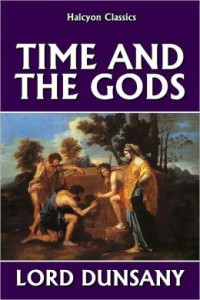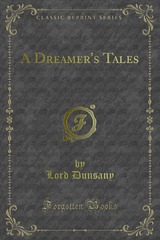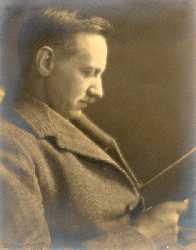Lord Dunsany Re-Read: Time and the Gods, Part 5
 Bill Ward and I are continuing our Lord Dunsany re-read with the next two stories published in the original Time and the Gods (not the omnibus). You can find a free copy of the book here and join in the discussion. Our rating system is pretty simple. One star is a standout, and two stars is truly notable. Most of Lord Dunsany’s fantasy work is already fairly remarkable, so even a “no star” story on this scale may be worth a look. This week we read “The Men of Yarnith” and “For the Honour of the Gods.”
Bill Ward and I are continuing our Lord Dunsany re-read with the next two stories published in the original Time and the Gods (not the omnibus). You can find a free copy of the book here and join in the discussion. Our rating system is pretty simple. One star is a standout, and two stars is truly notable. Most of Lord Dunsany’s fantasy work is already fairly remarkable, so even a “no star” story on this scale may be worth a look. This week we read “The Men of Yarnith” and “For the Honour of the Gods.”
Howard: Of the two I was most taken with “The Men of Yarnith,” even if it felt a little disjointed. Lord Dunsany returned again to his depiction of famine as a creature, although I think I liked its presentation better in one of the earlier stories. Through the first part it seems that the gods are real. I especially enjoyed the depiction of the seasons as entities that chase one another. By the second half, we readers realize we have been reading myths of the men of Yarnith, else we’d not receive the ending, where it’s discovered that the God is merely a stone figure, and the men renounce the gods and take responsibility for their own actions, and consequently their own salvation. Although this story held many fine passages, I don’t think I liked it as well as number of others.
As to “For the Honour of the Gods,” I think I like the idea better than the execution. Perhaps I’m growing tired of the theme. Here’s a land without religion, witness to lands destroyed by religion, and though they try to get by without the gods, they’re destroyed by them when they take it up. I’m an atheist myself so I’m in sympathy with the position but I don’t need to hear the same song every time I come to the juke box. If I pretend that I read it on my own apart from the other entries, I still don’t like it as well as Lord Dunsany at his best, though it’s still worth a read. I award “The Men of Yarnith” a star, and no star for “Honour.” What’s your take?
Bill: My impressions mirror your own, Howard, with one star to “Yarnith” as well. I may also be getting a bit of religion or anti-religion fatigue (but it is titled Time and the Gods after all!). I think part of the reason is because, paradoxically, we are only reading a few stories a week. I tend to look forward to them, hoping for something like “The Coming of the Sea,” “A Legend of the Dawn,” or “The Cave of Kai” each time. So the lesser stories, or the ones that are more repetitive, stick out a lot more when that’s all I’ve read for the week, when normally I would have moved past them more quickly. Possibly also the need to *say* something about each one makes them feel more repetitious as well. However, as we are always at pains to point out, even lesser Dunsany is some potent stuff, and I suspect if I’d read either of this week’s stories in isolation and not part of our series I would have been much more enthusiastic. That’s the problem with comparing Dunsany to Dunsany, he sets the bar really high for himself.
Both stories suggest mankind is better off without religion. “Yarnith” does so by showing what taking responsibility for success and putting it in human hands can do, and “Honour” by showing the pointless strife of religion. So, a positive inducement, and a negative warning — I would not be at all surprised to learn that these stories were written back to back. “Yarnith” is much more interesting on every level than “Honour,” in many ways it seems a reprise of “The Vengeance of Men,” with a happier ending. A shame those men of Arim didn’t live further away from the gods, since the men of Yarnith are doing just fine now, though wisely they keep on praying just the same. It also reminded me of “The Sword and the Idol” from A Dreamer’s Tales, which could almost be a spiritual sequel in a way — what happens when men finally see the strings of the puppet.
 As for the description of famine, I really liked the image, with the farmers throwing water on famine’s “dry grey fur,” and then famine returning just as soon as it had dried out again. That evokes images of parched landscapes and leeched-out soil. The extended metaphor of Yarni Zai clothed in rock is also some great stuff, and I think it sets up the revelation of the discovery of tool-marks in his face very well.
As for the description of famine, I really liked the image, with the farmers throwing water on famine’s “dry grey fur,” and then famine returning just as soon as it had dried out again. That evokes images of parched landscapes and leeched-out soil. The extended metaphor of Yarni Zai clothed in rock is also some great stuff, and I think it sets up the revelation of the discovery of tool-marks in his face very well.
I do wonder if the shift we have already seen from the early stories with the gods right up front and visible and active, to these stories where the gods are clearly images in the minds of men will continue.
Howard: I ought to know the answer, seeing as this is the third time I’ve read this collection, but I don’t recall what happens next. I guess we’ll find out together! Next week we’ll be reading “Night and Morning” and “Usury.” Hope to see you here.


0 Comments